What is the best summerhouse roofing system?
A summerhouse roof is the most dominant feature of the building and so must look good as well as protecting the inside of the building from the elements. Summerhouses are located in places where the view of the garden can be enjoyed at its best. As a consequence, they are often a central part of the garden and are designed to be an attractive part of the landscape. This is in contrast to shed roof that are often tucked away in the utility part of the garden.
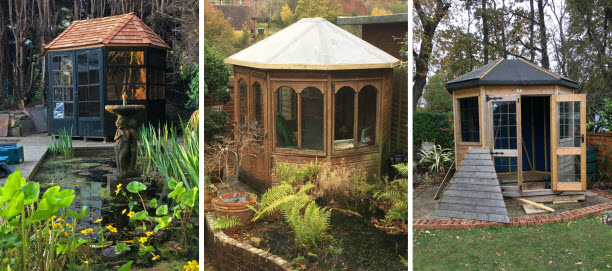 Three different summerhouse roof materials and their influence on the buildings appearance
Three different summerhouse roof materials and their influence on the buildings appearance
To achieve this attractive appearance buildings with hipped, hexagonal or octagonal roof shapes are often used. With these complex roof shapes, it can be a challenge choosing which is the best roofing material to achieve an attractive appearance, keep the wind and weather out and be as durable as possible.
So, what are the options for your summerhouse roof?
Before we start to delve into the different systems why is it so difficult to achieve an economic, good looking and weather proof system for a summerhouse roof? The main reason is the complex shape of summerhouse roofs and their size.
For an octagonal summerhouse each time the roof changes slope there is a joint in the roofing material and that joint is a prime opportunity for the weather to get into the building. The more joints there are in the roof the more chance of a leak.
Many house roofs have hipped roofs and these don't leak. Here you have the size factor working for you. The standard size of roof tiles and hip covers are made to suit the dimensions of domestic roofs. When these are scaled down to suit the dimensions of a summerhouse the overlaps just aren't enough to overcome the capillary action and ability of water to flow uphill which is required for a roof to be truly water proof.
Three popular systems for covering your summerhouse roof are:
- Cedar shingles
- EPDM
- Felt roof with timber over-roof
Cedar shingles for summerhouse roofs
Cedar shingles are a popular solution for summerhouse roofs. In my opinion they are the most attractive option. When first installed the wooden shingles are a variety of colours ranging from dark red through to yellow. The colours change daily with change in moisture due to rain and in the longer term the timber weathers to a beautiful silver-grey tone.
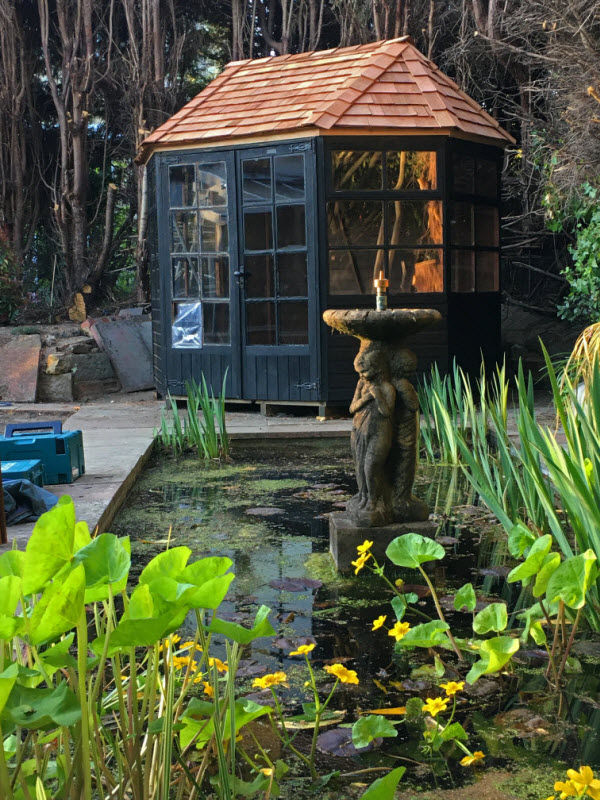 Summerhouse with cedar shingle roof
Summerhouse with cedar shingle roof
The shingles are of a size that seems to suit the scale of summerhouses and the ridges can be made relatively water proof by the addition of a 'soaker' under the hip tiles to help prevent the ingress of water along this joint.
The tiles are suitable for relatively sheltered areas. In my experience you also need to be extra vigilant with regards to the build up of fallen leaves on the roof and especially pine needles. A build up of leaves on the roof helps to promote decay as it slows down the roof drying out and provides a nice damp home for wood chomping bugs such as woodlice.
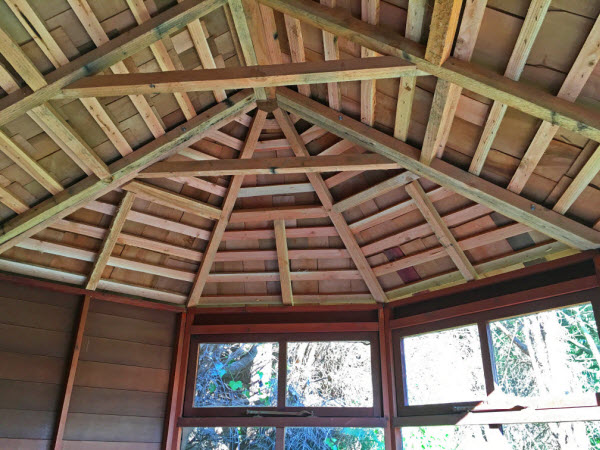 The inside of a shingle roof is quite attractive too
The inside of a shingle roof is quite attractive too
The material cost of cedar shingle summerhouse roofs is relatively high as is the cost of installation. Each shingle needs to be individually nailed in place ensuring the correct overlap to adjoining shingles and fixing with stainless steel, bronze or copper nails. Cedar shingles are resistant to decay to the acidic natural preservatives in their cells, these will quickly promote corrosion in normal steel or even galvanised roofing nails.
If cedar roofs are a bit pricey for you the next option has a very different appearance and a lower price point
EPDM summerhouse roofs
EPDM is an artificial sheet rubber material that has been extensively used on large commercial roofs for many years. It is increasingly being used on storage shed roofs even though it is more expensive than traditional shed felt, due to its longevity and durability. Which mean that it's cost per year is a fraction of the initially cheaper bituminous felt.
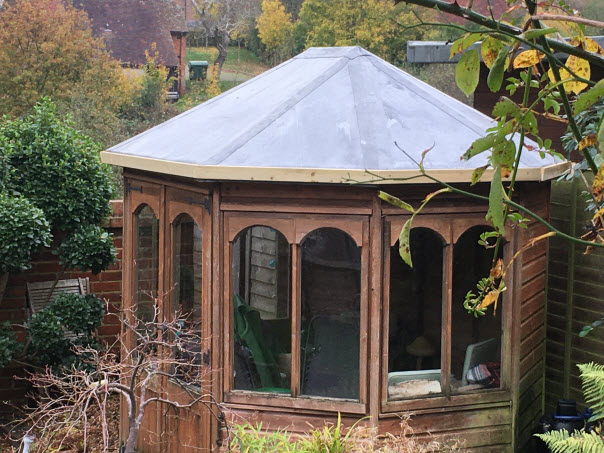 Using EPDM as a roof covering for an octagonal summerhouse
Using EPDM as a roof covering for an octagonal summerhouse
But can epdm be used on summerhouse roofs. EPDM can, at a stretch, be considered to have a similar appearance to lead, which has been used on top of the line summerhouses for many years. The appearance may not be to everyone's taste but the longevity of the roof (up to 50 years) and complete water tightness have big attractions to those who have suffered leaking roofs and struggle with achieving a weather tight summerhouse.
The main challenge is to ensure that the bond between the substrate of the roof and the epdm is secure and also that a good quality seam tape is used along with the correct primers to make the joint complete and long lasting.
The above two options are single layer roofs relying only on one method of keeping water out. There are those who consider that a two-stage approach works better along with potentially better looks.
Timber and roofing felt summerhouse roofs
If you have read some of the articles on felt and epdm you will know that I am not a big fan of using felt on shed roofs. So why would I be recommending felt roofing for summerhouses?
Lets' take a quick look at how the system works. The roofing system comprises a layer of roofing felt over the complete roof. Then a series of battens are fixed to the roof at the points where the roof changes direction. Timber panels made of treated shiplap timber or feather edge boards are made to the shape of each of the roof facets and fixed to the battens.
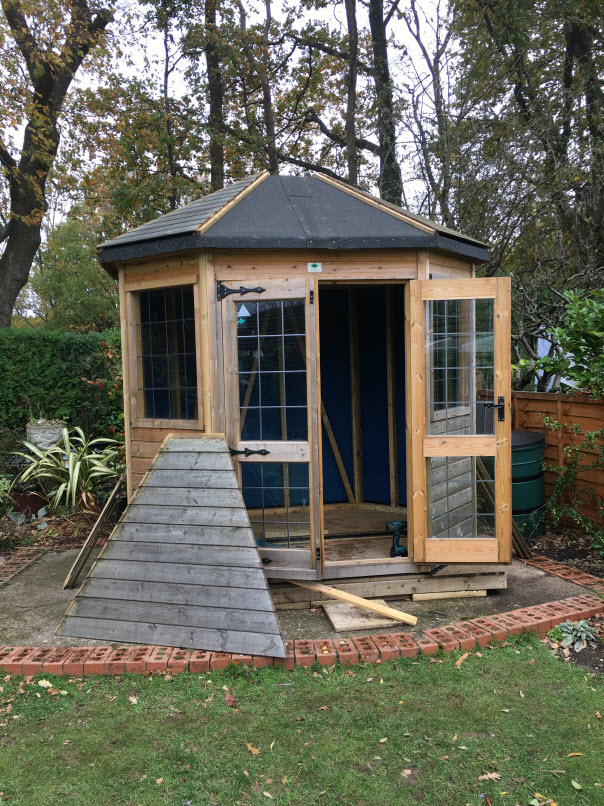 A summerhouse with the combined roofing felt and shiplap solution. Just before placing the final panel
A summerhouse with the combined roofing felt and shiplap solution. Just before placing the final panel
The overall effect is that the timber shiplap panels protect the roof beneath from the direct effects of the sun. So, there are less temperature extremes and the felt lasts longer. Also, most of the rainwater drains off the roof before it gets to the felt. The shiplap panel isn't a 100% waterproof system, but it doesn't need to be as there is the felt beneath even if a significant amount of water makes it through. The shiplap timber will warp and age and eventually need to be replaced but all the while it is protecting the roofing felt beneath.
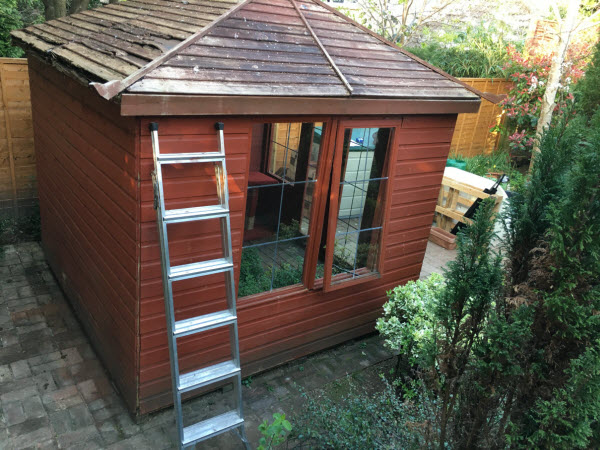 The wood on this summerhouse roof eventually rotted but the felt gave an extra layer of protection
The wood on this summerhouse roof eventually rotted but the felt gave an extra layer of protection
This approach does have some benefits even if neither of the solutions by themselves are particularly brilliant.
Which is the best summerhouse roofing system?
There isn't one system that does it all. I mentioned at the beginning that all roofing systems are a compromise between cost, aesthetics and durability. This definitely seems to be the case here.
The cedar roof is beautiful and at the top end for material and installation cost. Cedar shingle suppliers say that their products will last 25 years. But I have certainly replaced the tiles on several cedar roofs which are 10-15 years old.
The epdm roof is probably the most durable and long lasting. I like the appearance, as with the seam tape it looks similar to lead but my feedback is that it's appearance isn't to everyone's taste.
The roofing felt combined with an over-roof does seem to be two not so brilliant systems that when combined seem to work quite well.
Do you need a summerhouse roof repair?
Whichever system you decide works best for your summerhouse roof let me know via the contact page.
For summerhouse roof repairs I cover the area of Kent, East Sussex and South London.

Keep in touch with our monthly newsletter
Shed Building Monthly




